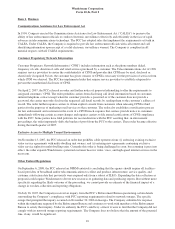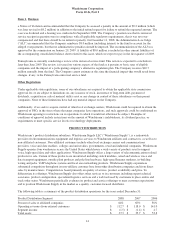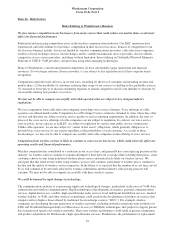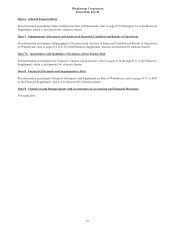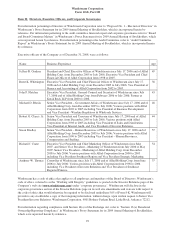Windstream 2008 Annual Report Download - page 67
Download and view the complete annual report
Please find page 67 of the 2008 Windstream annual report below. You can navigate through the pages in the report by either clicking on the pages listed below, or by using the keyword search tool below to find specific information within the annual report.
Windstream Corporation
Form 10-K, Part I
Item 1A. Risk Factors
In addition, our ability to borrow funds in the future will depend in part on the satisfaction of the covenants in our
credit facilities and its other debt agreements. If we are unable to satisfy the financial covenants contained in those
agreements, or are unable to generate cash sufficient to make required debt payments, the lenders and other parties to
those arrangements could accelerate the maturity of some or all of our outstanding indebtedness.
We may not generate sufficient cash flows from operations, or have future borrowings available under our credit
facilities or from other sources sufficient to enable us to make our debt payments or to fund dividends and other
liquidity needs. We may not be able to refinance any of our debt, including our credit facilities, on commercially
reasonable terms or at all. If we are unable to make payments or refinance our debt, or obtain new financing under
these circumstances, we would have to consider other options, such as selling assets, issuing additional equity or debt,
or negotiating with our lenders to restructure the applicable debt. Our credit agreement and the indentures governing
our senior notes may restrict, or market or business conditions may limit, our ability to do some of these things on
favorable terms or at all.
As of December 31, 2008, Moody’s Investors Service (“Moody’s”), Standard & Poor’s Corporation (“S&P”) and Fitch
Ratings (“Fitch”) had granted Windstream the following senior secured and senior unsecured credit ratings:
Description Moody’s S&P Fitch
Senior secured credit rating Baa3 BBB BBB-
Senior unsecured credit rating Ba3 BB BB+
Outlook Stable Stable Stable
Factors that could affect Windstream’s short and long-term credit ratings would include, but are not limited to, a
material decline in the Company’s operating results, increased debt levels relative to operating cash flows resulting
from future acquisitions, increased capital expenditure requirements, or changes to our dividend policy. If
Windstream’s credit ratings were to be downgraded from current levels, the Company would incur higher interest costs
on its borrowings, and the Company’s access to the public capital markets could be adversely affected.
Our operations require substantial capital expenditures.
We require substantial capital to maintain, upgrade and enhance our network facilities and operations. During 2008, we
incurred $317.5 million in capital expenditures. In addition, our current dividend practice utilizes a significant portion
of our cash generated from operations and therefore limits our operating and financial flexibility and our ability to
significantly increase capital expenditures. While we have historically been able to fund capital expenditures from cash
generated from operations, the other risk factors described in this section could materially reduce cash available from
operations or significantly increase our capital expenditure requirements, and these outcomes could cause capital to not
be available when needed. This could adversely affect our business.
Unfavorable changes in financial markets could adversely affect our pension plan investments resulting in material
funding requirements to meet pension obligations.
The Company’s pension plan invests in marketable equity securities, including marketable debt and equity securities
denominated in foreign currencies, which are exposed to changes in the financial markets. As of December 31, 2008,
the fair market value of these investments, totaling $654.0 million, declined 34.7 percent from approximately $1,001.0
million at December 31, 2007, primarily due to declines in the market value of assets held. As a result of the decline in
fair market value of these investments, the Company will be required by the U.S. Pension Protection Act of 2006, as
corrected by the Worker, Retiree, and Employer Recovery Act to make a cash contribution in 2010 for the January 1,
2009 valuation period to meet minimum funding requirements. Returns generated on plan assets have historically
funded a large portion of the benefits paid under the Company’s pension plan. Continued returns below our currently
estimated long term rate of return of 8.0 percent could significantly increase our contribution requirements, which
could adversely affect our cash flows from operations.
We may not realize the anticipated synergies, cost savings and growth opportunities from acquisitions.
As part of our business strategy, we may pursue mergers and acquisitions from time to time with other companies as
opportunities may arise. The success of potential transactions will depend, in part, on our ability to realize the
19



